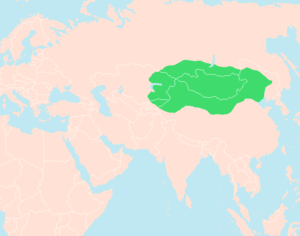Huduershidaogao
Huduershidaogao (Chinese: 呼都而尸道皋), born Yu, was a chanyu of the Xiongnu Empire. The brother and successor of Wuzhuliu Chanyu, he reigned from 18 to 46 AD.
| Yu | |
|---|---|
| Huduershidaogao Chanyu | |
 Domain and influence of the Eastern Huns | |
| Reign | c. 18–46 AD |
| Predecessor | Wulei Chanyu |
| Successor | Wudadihou |
| Born | 34 BC |
| Dynasty | Modu Chanyu |
| Father | Huhanye |
Biography
Yu was the eldest surviving son of Wuzhuliu Chanyu upon his death in 13 AD, but Yu was passed over in succession in favor of his half-brother, the Wulei Chanyu. When Wulei died in 18 AD, Yu succeeded him as the Huduershidaogao Chanyu.[1]
In 19 AD, Wang Mang set up Xubu Chanyu as a rival to Huduershidaogao and stationed a large army on the frontier. Xubu died soon afterward and the army never set out.[2][1]
Huduershidaogao killed his half-brother Yituzhiyashi who was next in line to the throne and pro-Chinese.[2]
In 24 AD, the Gengshi Emperor sent an embassy to the Xiongnu, but Huduershidaogao felt that they did not pay him proper respect. The Gengshi Emperor died in 25 AD.[2][1]
In 28 AD, Huduershidaogao attacked Emperor Guangwu of Han but was defeated.[3]
In 35 AD, the Xiongnu forced the Han to withdraw from Shuofang Commandery.[3]
In 37 AD, the warlord Lu Fang was defeated and fled to the Xiongnu court.[3]
In 44 AD, Xiongnu raiding parties reached as far as Tianshui, Youfufeng, and Shangdang commanderies.[3]
In 45 AD, a Xiongnu raid attacked Zhongshan Commandery.[3]
In 46 AD, Huduershidaogao died at the age of 80 and was succeeded by his son Wudadihou.[4]
Footnotes
- Loewe 2000, p. 167.
- Crespigny 2007, p. 992.
- Crespigny 2007, p. 993.
- Crespigny 2007, p. 878.
References
- Barfield, Thomas (1989), The Perilous Frontier: Nomadic Empires and China, Basil Blackwell
- Bichurin N.Ya., "Collection of information on peoples in Central Asia in ancient times", vol. 1, Sankt Petersburg, 1851, reprint Moscow-Leningrad, 1950
- Chang, Chun-shu (2007), The Rise of the Chinese Empire 1, The University of Michigan Press
- Cosmo, Nicola Di (2002), Ancient China and Its Enemies, Cambridge University Press
- Cosmo, Nicola di (2009), Military Culture in Imperial China, Harvard University Press
- Crespigny, Rafe de (2007), A Biographical Dictionary of Later Han to the Three Kingdoms, Brill
- Loewe, Michael (2000), A Biographical Dictionary of the Qin, Former Han, and Xin Periods, Brill
- Taskin B.S., "Materials on Sünnu history", Science, Moscow, 1968, p. 31 (In Russian)
- Whiting, Marvin C. (2002), Imperial Chinese Military History, Writers Club Press
| Preceded by Wulei |
Chanyu of the Xiongnu Empire 19 – 46 AD |
Succeeded by Wudadihou |